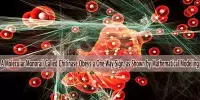A quantum gyroscope is a highly sensitive gadget that measures angular rotation using quantum mechanical principles. It is a gyroscope that measures angular velocity or rotation using quantum mechanics principles. The first of these was created by Richard Packard and his colleagues at the University of California, Berkeley. Because of the great sensitivity, a larger version may possibly detect phenomena such as minute variations in the rotating rate of the Earth.
Gyroscopes are devices that detect changes in orientation and are extensively utilized in navigation systems, aeronautical applications, and robotics. Traditional gyroscopes measure rotation using mechanical principles such as angular momentum conservation. However, quantum gyroscopes leverage the unique properties of quantum particles to achieve high-precision measurements.
Principle
Brian Josephson, a PhD student at Cambridge University, proposed in 1962 that an electric current could transfer between two superconducting materials even if they were separated by a thin insulating barrier.
The Josephson effect has evolved to refer to the various behaviors that occur in any two weakly coupled macroscopic quantum systems—systems made up of molecules with identical wavelike properties. When two superfluids (zero friction fluids) are connected via a weak link and pressure is given to the superfluid on one side of the weak link, the fluid will oscillate from one side of the weak link to the other.
Here are some key concepts and features of quantum gyroscopes:
- Quantum Interference: Quantum gyroscopes rely on quantum particle interference, such as atoms or photons. These particles behave like waves, and depending on their relative phases, they can interfere constructively or destructively.
- Atom Interferometry: Atom interferometry is a typical method for creating a quantum gyroscope. A cloud of ultra-cold atoms is manipulated using lasers and magnetic fields to create interference patterns in this method. Changes in rotation rate can cause shifts in these interference patterns, allowing angular velocity to be measured.
- Sagnac Effect: The Sagnac effect, which is well-known in classical optics and general relativity, is frequently used in quantum gyroscopes. Light or matter waves flow in opposite directions along a closed loop in a Sagnac interferometer. When the loop rotates, the interference pattern varies, revealing the rotation rate.
- High Precision: Quantum gyroscopes are well-known for their accuracy and sensitivity. They can detect very minute changes in angular velocity, making them useful for applications requiring precise navigation and position monitoring.
Applications
Quantum gyroscopes have potential applications in various fields, including aerospace, autonomous vehicles, and geophysics. They can improve the performance of inertial navigation systems, enabling more accurate positioning and navigation without relying on external signals like GPS.
Challenges
Building viable quantum gyroscopes can be difficult due to the necessity for precise control of quantum states and extremely stable surroundings to limit external interference.
Quantum gyroscope research is underway, and they hold the promise of transforming navigation technology by giving highly accurate and reliable orientation and rotation readings. As of my last knowledge update in September 2021, quantum gyroscopes were still a nascent technology, and there may have been significant advancements and commercialization efforts since then.
















